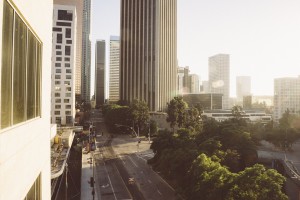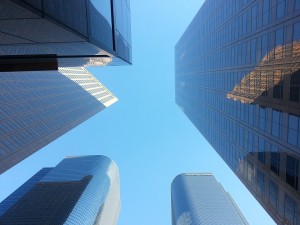In this video from the LA City Council, are recommendations for council action vis-à-vis the Public Works and Gang Reduction Committee in to nearby businesses and how they are impacted by the issuant of sidewalk vending permits. Recommendations included a two-tiered penalty structure, with higher penalties for vending without a permit, and less severe ones for vending in violation of permit conditions.
Category Archives: Infrastructure
Baby You Can Drive My Car
 Or can you? When it comes to LA, despite the fact that the city works hard to keep up with environmentally high standards, no one seems to be prepared to give up their own automobile vehicles. Indeed, ever since the late 1940s and the economic boom that ensued following the Second World War, LA has been car crazy. And hence traffic has been the result…along with the environmental footprint.
Or can you? When it comes to LA, despite the fact that the city works hard to keep up with environmentally high standards, no one seems to be prepared to give up their own automobile vehicles. Indeed, ever since the late 1940s and the economic boom that ensued following the Second World War, LA has been car crazy. And hence traffic has been the result…along with the environmental footprint.
Thanks to Tesla and Google though, there is hope, although LA proper has a long way in getting up to the standards that are already in process in Silicon Valley. So given all of this, what is happening at this year’s LA Auto Show? Intel is planning to launch a $250 million autonomous car program while Argus Cyber Security is focused on hacking prevention. ReachNow – the car-sharing service created by BMW will be expanding and there is a planned automated future by Ford. CEO of NextEv discussed her vision for the future in which cars will be tackling both software and hardware and Lucid Motors presented its electric sports car prototype.
Still, one of the issues LA has to face is the real fact that it has to respond to celebrity culture and that means status and speed. As Tamar Warren concluded in her article in The Verge, “In a car town, a visit to the Los Angeles Auto Show is an opportunity to see an industry caught in a crossroads.”
Measure M and LA Infrastructure
 LA County voters approved an increase in sales tax. With this, tens of billions of dollars will be raised to put toward rail and road enhancement projects, known as Measure M. It is hoped that the amount will raised will be approximately $860 million per annum for the Sepulveda Pass and extensions spanning the San Fernando and San Gabriel valleys.
LA County voters approved an increase in sales tax. With this, tens of billions of dollars will be raised to put toward rail and road enhancement projects, known as Measure M. It is hoped that the amount will raised will be approximately $860 million per annum for the Sepulveda Pass and extensions spanning the San Fernando and San Gabriel valleys.
Measure M – the expansion of the more recent half-cent sales tax hike Measure R – garnered overall support as it is hoped that it will result in the creation of construction jobs, while substantially reducing congestion.
In addition, last week, Virgina Grebbin, Chief of Staff spoke at the 28th edition of CityAge. Entitled Build the Future, it focused on the current state of LA and how to maximize the city’s development via design, economy, business, government and research. Grebbien honed in on the California infrastructure part, figuring out project priorities, private partnership influence and how LA compares to other US states vis-à-vis airports, bridges, public areas and roads.
Downtown LA Expansions
 The Honda of Downtown Los Angeles dealership on the Figueroa Corridor is expanding. With this it will be moving from its long-held location at 1540 S. Figueroa St., by the 10 Freeway overpass, to the intersection of Martin Luther King Jr. Boulevard and Hoover Street near Exposition Park, where the new dealership will be built. The Department of City Planning has documents attesting to Honda’s plans to demolish an existing two-story building and raise a pair of five-story structures, one on each side of Hoover Street, to house showrooms, service facilities and vehicle storage areas. The new dealership, slated for completion in 2021, would effectively be the new headquarters of Honda of Downtown, though the property on Figueroa Street would still operate as a dealership for used cars and performance vehicles, according to a report from the real-estate website Urbanize.la.
The Honda of Downtown Los Angeles dealership on the Figueroa Corridor is expanding. With this it will be moving from its long-held location at 1540 S. Figueroa St., by the 10 Freeway overpass, to the intersection of Martin Luther King Jr. Boulevard and Hoover Street near Exposition Park, where the new dealership will be built. The Department of City Planning has documents attesting to Honda’s plans to demolish an existing two-story building and raise a pair of five-story structures, one on each side of Hoover Street, to house showrooms, service facilities and vehicle storage areas. The new dealership, slated for completion in 2021, would effectively be the new headquarters of Honda of Downtown, though the property on Figueroa Street would still operate as a dealership for used cars and performance vehicles, according to a report from the real-estate website Urbanize.la.
There’s not such good news for anther transport-related expansion in Los Angeles. BNSF Railway Co.’s new terminal near the Port of Los Angeles – that has been in the works now for close to 10 years with a $50m price tag – is facing challenges from a local judge who ruled that the terminal’s environmental review was not adequately undertaken. This could actually bring the project – that would offer city residents much-needed rail capacity – to an end. Right now BNSF is considering its options: to appeal, negotiate, or abandon efforts entirely.
Meanwhile, it seems LA is a great place for a start-up to expand. According to Daniel Wirjoprawiro, it is “the fastest growing tech market in the United States.” In an article in StartUpSmart (based in Australia) he gives 6 reasons to explain this, having himself already made the “move to the City of Angels.” These are:
- Burgeoning ecosystem
- Establishment of Chinese companies in the region
- More affordable than other tech regions such as San Francisco
- The level of talent: “LA has more engineering graduates than any other metro city.”
- Diversity resulting in the capacity of the ecosystem to build “a new generation of companies that are distinctly different in culture, creativity and aspirations from companies that stem from less diverse cities.”
- Quality of life.
Perhaps the judge who gave the negative ruling on BNSF Railway Co. should read Wirjoprawiro’s article and reconsider his position.
LA City Joins CENIC
 The City of Los Angeles recently joined up with CENIC – the Corporation for Education Network Initiatives in California. The 100 Gbps research and education network is the provider of high speed access to California’s schools, colleges and universities.
The City of Los Angeles recently joined up with CENIC – the Corporation for Education Network Initiatives in California. The 100 Gbps research and education network is the provider of high speed access to California’s schools, colleges and universities.
This move will be instrumental in advancing California’s infrastructure. Currently, California can access Los Angeles Open Data (datasets on the city services, economy, safety, budget, transportation, parks and more) and Los Angeles GeoHub (location-based open data on business, health, recreation, safety, and more), with this move, according to a recent article in BusinessWire, “educational institutions and researchers will now have 1,000 times faster access to those resources.”
This sentiment was echoed by Associate VP for IT Services at Stanford University and CENIC Board of Directors Chair, William Clebsch who said:
“This peering partnership between CENIC and the City of Los Angeles represents a unique opportunity to pair the sophisticated research and analysis being done at California’s great universities with the massive data being generated in one of our country’s most progressive Smart Cities, Los Angeles. This will lead to advances in urban living that have not been possible before.”
While this is indeed a great first step – increased access is always welcome – it seems that California still has what to do on infrastructure enhancements. Some examples include: a) promotion of P3, b) bolstering of competitive bidding and c) a reduction in the amount of PLAs.
Hopefully with the City of LA’s new connection to the CNEIC, infrastructure will benefit, in part due to its Iaas (infrastructure as a service) cloud component for its member institutions.